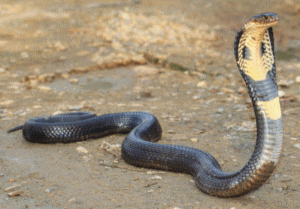 SKC Films Library |
| SKC Films Library >> Suborder Serpentes |
| King Cobra Ophiophagus hannah Description The king cobra can reach a length of 18 feet, but averages 10 to 12 feet. Adults are yellow, green, brown, or black in color, with yellowish or white cross-bars or chevrons on the body; the belly may be uniform in color or ornamented with bars. The throat is light yellow or cream-colored. Juveniles are jet-black, with yellow or white cross-bars on the body and tail and four similar cross-bars on the head. Distribution and Habitat The king cobra is found in northern India, east to southern China and Hong Kong, south throughout the Malay Peninsula, and into western Indonesia and the Philippines. It typically lives near streams in dense or open forest, bamboo thickets, adjacent agricultural areas, and dense mangrove swamps, but has also been found in mountainous regions up to 6,500 feet above sea level. Habits and Behaviors Unlike true cobras, the king cobra is active both day and night. King cobras live solitary lives, coming together only for mating. They may, however, mate with the same snake each year. A king cobra will not attack unless cornered or provoked -- with the exception of nesting females, which may attack without provocation. When in a threat display, a king cobra will raise the front of its body about 3 feet off the ground (as in the picture); it is able to follow its enemy in this position over a considerable distance. Diet King cobras typically feed on other cold-blooded animals, especially other snakes. Reproduction Breeding usually occurs from January through April. The female lays from 21 to 40 eggs in a nest made by piling leaves and branches into a pile. She will remain on top of the nest to guard the eggs, with the male remaining close by, until the eggs hatch after 60 to 70 days. Just before the young emerge, the female abandons them, presumably to keep her from eating her own young. The female can store sperm for several years, using it to impregnate herself several times. Venom The venom of the king cobra is very potent -- one gram can kill 150 people. It is a strong neurotoxin, affecting the respiratory centers in the brain. Death results from respiratory arrest and cardiac failure. The venom of a juvenile king cobra is just as potent as that of an adult. Scientific Classification Phylum Chordata |
| SKC Films Library >> Suborder Serpentes This page was last updated on June 20, 2018. |
